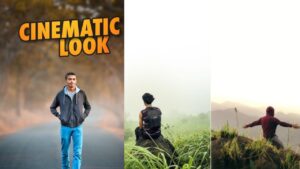Makes a Photo Cinematic
1. Introduction
Cinematic photo editing aims to create film-like images with strong emotions, dramatic lighting, and rich color grading. Inspired by movies, this editing style is popular in photography, social media, and visual storytelling.

2. What Makes a Photo Cinematic?
- Emotionally compelling
- Movie-style colors (teal & orange, muted tones)
- Shallow depth of field
- Moody lighting
- Widescreen aspect ratio
- Strong narrative or mood
3. Origins of the Cinematic Look
Originating from Hollywood films, the cinematic look in photography draws from directors like Nolan and Kubrick. This influence brought storytelling, color grading, and framing to still photography.
4. Key Elements of Cinematic Photos
- Color grading
- Lens blur or bokeh
- Directional lighting
- Film grain or textures
- Creative shadows
- Balanced framing and negative space
5. Color Theory
Using color theory:
- Teal and orange create depth and emotion
- Complementary/analogous color schemes enhance mood
- Split toning: warm highlights, cool shadows
6. Aspect Ratios & Cropping
Widescreen cinematic aspect ratios:
- 2.35:1 or 2.39:1
- 16:9 for digital
- Letterboxing (black bars) adds film feel
7. Lighting for Cinematic Impact
- Golden hour provides soft shadows
- Backlight or rim light outlines subjects
- Low-key light creates mystery
- Window or practical lights build realism
8. Tone Curves and Color Grading
- Use S-curves to add contrast
- Raise black point for vintage fade
- Use blue shadows/yellow highlights for cinematic tones
- Control HSL sliders for precise color tuning
9. LUTs and Presets
- LUTs = color grading files for consistent look
- Presets = saved edits in Lightroom, mobile, etc.
- Simulate Kodak, Fujifilm, blockbuster tones
- Save time, ensure visual consistency
10. Best Editing Software
Desktop:
- Lightroom
- Photoshop
- Capture One
- Luminar Neo
Mobile:
- Lightroom Mobile
- Snapseed
- VSCO
- PicsArt
- Darkroom
11. Mobile Cinematic Editing
Even with smartphones:
- Use Lightroom Mobile curves
- Apply teal-orange LUTs
- Add lens blur and letterbox bars
- Tune exposure, highlights, and shadows
12. Cinematic Styles
- Teal & Orange (Hollywood style)
- Muted tones (moody, vintage)
- Retro/film (grain, fade)
- Black & White (noir, emotional)
- Neon/Cyberpunk (night city lights)
- Golden tones (nostalgia)
13. Creating Your Own Look
- Use consistent color palettes
- Stick to a mood (dramatic, calm, suspense)
- Analyze film stills for inspiration
- Develop your own presets and LUTs
14. Cinematic Portrait Editing
- Brighten face/eyes subtly
- Add soft background blur
- Use radial filters for vignettes
- Apply dodge & burn for shaping light
- Maintain natural skin tones
15. Cinematic Landscapes
- Enhance shadows and drama
- Add warmth to skies
- Desaturate greens for mystery
- Include fog, sun flares, or mist
- Use gradient filters for sky enhancements
16. Day-to-Night Effects
- Lower exposure and add cool tones
- Simulate artificial lights
- Add glow or lighting overlays
- Mask light sources for realism
17. Black & White Cinematic Photos
- High contrast and texture
- Emphasize shape and composition
- Use vignette and grain
- Focus on facial emotion and lighting
18. Common Mistakes
Avoid:
- Overediting (unnatural look)
- Overexposure
- Inconsistent style
- Poor skin tone adjustments
- Oversharpening or too much contrast
19. Advanced Editing Techniques
- Masking for light control
- Dodge & burn for realism
- Luminosity masks for tone targeting
- AI tools for sky and subject enhancement
- 3D LUTs, gradient maps, flares
20. Conclusion
Cinematic photo editing is storytelling through visuals. Mastering light, color, mood, and technique helps you create emotion-driven, film-inspired images. It’s not just about looking cool—it’s about making viewers feel something.
🔗 Helpful Resources
- Free LUTs: Lutify.me
- Presets: Adobe Exchange, FilterGrade
- Tutorials: Peter McKinnon, Mango Street, Daniel Schiffer
- Apps: Lightroom, Snapseed, VSCO
